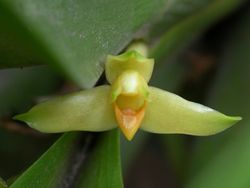CZ:Featured article/Current: Difference between revisions
imported>Johan Förberg No edit summary |
imported>Johan Förberg No edit summary |
||
| Line 4: | Line 4: | ||
''Heterotaxis'' are comparatively large and robust plants among orchids. According to their morphologic characteristics they can be split into two main groups, identifiable at the first glance, all bearing comparatively minute flowers growing from several or few inflorescences produced sequentially | ''Heterotaxis'' are comparatively large and robust plants among orchids. According to their morphologic characteristics they can be split into two main groups, identifiable at the first glance, all bearing comparatively minute flowers growing from several or few inflorescences produced sequentially | ||
from each leaf axil, almost any time of the year. As any species once subordinated to ''[[Maxillaria]]'' the inflorescences are lateral, they hardly are taller than the pseudobulb and often are very short, bearing just one flower. All species have small thick flowers, which frequently do not open entirely, ordinarily yellowish, but also orange or white, sometimes with purple-bluish, lilac or brown-red spots. A thickening or variable calli on the center of the lip are common, sometimes covered by waxy glandular [[trichome]]s that attract [[pollinator]]s, mostly meliponine bees. | from each leaf axil, almost any time of the year. As any species once subordinated to ''[[Maxillaria]]'' the inflorescences are lateral, they hardly are taller than the pseudobulb and often are very short, bearing just one flower. All species have small thick flowers, which frequently do not open entirely, ordinarily yellowish, but also orange or white, sometimes with purple-bluish, lilac or brown-red spots. A thickening or variable calli on the center of the lip are common, sometimes covered by waxy glandular [[trichome]]s that attract [[pollinator]]s, mostly meliponine bees. Their [[column]] is very short and the fruits show lateral dehiscence. ('''''[[Heterotaxis|Read more...]]''''') | ||
Revision as of 08:34, 4 May 2011
Heterotaxis is a genus of orchids formed by a group of circa fourteen epiphytic neotropical species which previously were considered part of genus Maxillaria. Most of the species are robust plants with shiny dark green leaves which presents a showy display making a very good first impression but that end disappointing because of their small flowers, usually yellow, which, because of their short inflorescences, hide between the foliage and can hardly be seen. Although the species that belong to this genus are easy to identify as members of it, because several species are highly variable and some species are very similar to others, to differentiate them is hard. The limits between each species not seem well established, with few exceptions, thus the concept of some species sometimes overlap others. Among all Heterotaxis species, H. equitans is a favorite of orchid collectors because it has visible and showy white and dark blue-purple flowers; and H. valenzuelana is sometimes collected due to the uniqueness of their fan shaped foliage.
Heterotaxis are comparatively large and robust plants among orchids. According to their morphologic characteristics they can be split into two main groups, identifiable at the first glance, all bearing comparatively minute flowers growing from several or few inflorescences produced sequentially from each leaf axil, almost any time of the year. As any species once subordinated to Maxillaria the inflorescences are lateral, they hardly are taller than the pseudobulb and often are very short, bearing just one flower. All species have small thick flowers, which frequently do not open entirely, ordinarily yellowish, but also orange or white, sometimes with purple-bluish, lilac or brown-red spots. A thickening or variable calli on the center of the lip are common, sometimes covered by waxy glandular trichomes that attract pollinators, mostly meliponine bees. Their column is very short and the fruits show lateral dehiscence. (Read more...)
